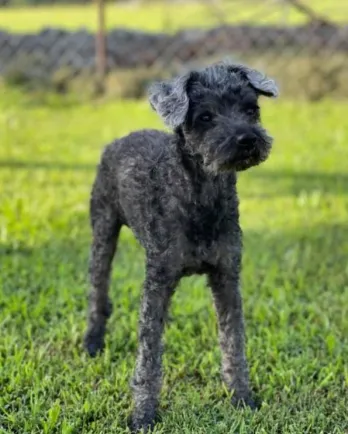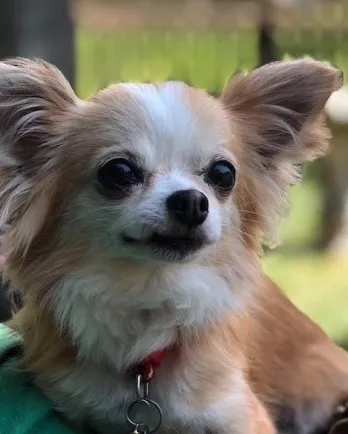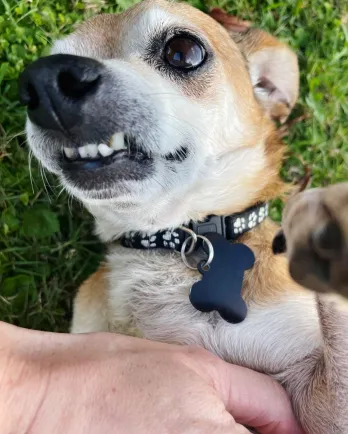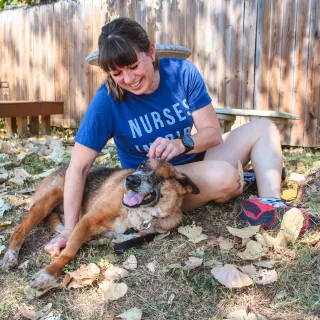The Importance of Dog-Friendly Landscaping for Senior Pets
Editor's Note: This is a guest post on the Grey Matters Blog and not written by anyone affiliated with Grey Muzzle. We allow guest contributors from time to time in order to provide our supporters with a wide range of topics pertaining to senior dogs.
As your dog ages, it becomes more important to make sure that their home is safe. Your pets’ joints may not work as well as they once did, so they may need some help climbing once easily conquered stairs. Making a few changes to your home will help your senior dogs stay safe and happy.
When dogs enter their twilight years, they may have some difficulty adjusting to age-related limitations. As pet owners, it’s up to us to help them adjust. One of the easiest ways to do this is to revamp your backyard into a senior-friendly area.
Even with minor changes, dog-friendly landscaping can help bring back your grey-muzzled friend’s vigor. By replacing unsafe features, your pets will have less chance of injuring themselves. And, with some simple design changes, a backyard can easily accommodate the special requirements your senior dog may need.
Here are some suggested areas to focus on when designing a senior dog-friendly backyard:
Watch Out for Dangerous Flora
As your pets age, they might not be as easily able to handle some of the environmental dangers that are often found in backyards. While most prudent pet parents will ensure that their yards are safe, it always pays to double-check.
Beware of Unsafe Plants
Some of the most common backyard dangers come from plants. Certain plants and flowers may pose a threat. And senior dogs might not be able to handle some of the toxins [delete: involved] in many backyard plants.
Even if your pet has never had an issue before, it’s time to assess your plants. Once your dog becomes a senior, head out back and start identifying the flora. As dogs age, their behavior might change. So, even if they’ve never nibbled on plants before, that might change. Avoid issues by eliminating any potentially dangerous plants.
According to the ASPCA, there are hundreds of plants that are dangerous for dogs. Common backyard plants and signs that your dog may have ingested them include:
- Vomiting, lethargy, diarrhea
- Cyanide poisoning, shock, difficulty breathing
- Oral irritation, drooling, vomiting
- Vomiting, diarrhea
- Sago Palm: Vomiting, liver failure, death
- Low blood pressure, tremors, death
- Cardiac failure, seizures, death
This is just a short list, but the dangers are clear. From mere discomfort to death, these plants can harm even the healthiest dogs. Senior dogs may be more vulnerable, so extra care must be taken.
You can use identifying apps to research any mysterious plant growth. Once you’ve found the details, determine if the plants need to go. To be safe, you should remove anything that could pose an issue. Consider donating them if you have access to a plant donation program.
Don’t forget about the human edibles, as gardens and fruit trees can be just as harmful. Choking hazards could arise from fruits with pits, not to mention the various dangerous compounds in common fruits like apricots and peaches.
Check Your Groundcover
Your choice of ground cover isn’t necessarily life and death, but it is still important. With a senior dog, you may not have to worry about too much excitement and digging up the yard. Most grasses are safe for eating and their paws. Kentucky Bluegrass and Bermuda grass are resilient options that grow well. They also have deep roots to stand up to the traffic of even an active senior pet.
Grass can be finicky, and the upkeep can be more work than it’s worth. In that case, examine other living options. For example, clover and creeping thyme are common. Clover is durable and grows fast. It will stay green even when in a potty area, requires little extra care, and costs $4 to cover 4,000 square feet.
Creeping thyme is similar. It grows purple and white, and it smells great. It’s safe for dogs and gives the yard a splash of color. Like clover, it’s cheaper and requires far less upkeep.
Of course, any grass yard may turn to mud in the rain. If your yard is prone to sloppiness, then consider grass alternatives. Common options include:
- Artificial grass: Durable and easy to clean, but expensive, with prices ranging from $5 to $20 per square foot.
- Mulch chips: Soft on paws and odor-absorbing. It needs some extra drainage. And never use cocoa mulch which is poisonous to dogs!
- : Smaller, rounded stones can be paw-friendly. It’s easy to clean and durable, but can pose choking hazards.
- Crushed limestone and decomposed granite: An alternative to gravel. It’s easier on paws, easy to clean, and much cheaper than artificial grasses.
- Paver stones: Durable and can feature designs but watch out for the surfaces. Stone surface temperatures can reach 40° hotter than air temperatures.
Remember to test each product before committing to a project. Buy mulch and grass samples to ensure your pup doesn’t have any reactions. And keep it simple; it just needs to be safe and inviting.
Eliminate Unsafe Equipment
Once you’ve worked on the plants, get rid of any potentially dangerous equipment.
Avoid Metal Objects
It goes without saying, but metal can be dangerous. Your old dog might not be running around the yard as much as he once did, but metal objects can still pose a risk. Remove any edging or barriers with sharp edges. Look closely at fences with spikes, house siding, and garden barricades.
Also, check any patio furniture. Metal equipment can rust and become weak. This can lead to sharp edges or even dangerous furniture. Choose wood or plastic furniture instead.
Use plastic in place of all metal in your yard. Replace barricades with wooden fences. Take down fence signs or hanging decorations that can pose a threat to a senior pet. You might even want to reconsider metal child play equipment, like slides. While it’s unlikely that your dog will want to suddenly start using playground equipment, leave no chance. As dogs age, their usual behaviors may change. To be safe, do the following:
- Remove old metal items.
- Replace metal with durable wood or plastic.
- Use hedges in place of metal fences.
- Use raised beds and areas to keep dogs away from dangerous fencing or metal objects.
If you must use metal objects in your backyard, then ensure they are safe. File down sharp edges or cover them with edge guards. Move any heavy items out of the dog area and keep things like toolboxes secured.
Senior-fy Your Objects
While you’re sprucing up your yard, check your dog’s items too. Staying active is important for senior dogs, but their toys should match their energy level. Buy them toys designed to keep them stimulated and active. And best of all, the right toy can make a senior feel like a pup again.
Open yards allow a senior pet to run in safety. Grass yards and those with soft ground covers will ensure paws are kept safe. And, since you’ve already removed dangerous plants and metal objects, your dogs are free to range on their own, under your watchful eye, of course.
If your dog is a fan of toys, there are many senior options, including:
- Soft-bite tug-of-war toys
- Easy-to-see balls for fetch games
- Scent games and food puzzles to keep their minds active
- Soft comfort toys for outdoor lounging
Of course, not every dog will stop playing just because their muzzles go grey. Follow your dog’s lead when it comes to playtime. Keeping them active is most important. And by keeping the backyard safe, they have an entire area to play in, helping them stay fit and mobile.
Keep Areas Separate and Safe
Of course, not every family can devote the entire yard to a dog. Still, with a senior dog, common yard features can sometimes present dangers. In that case, it may be time to create safe zones for your pet.
Be Ready with Fences
Fences are a great way to partition a yard for different uses. Families with kids and senior dogs can keep their play areas separate when needed. And pet zones can be kept away from [deleted “dangerous”] gardens and patio equipment.
Always be sure to match the fence to the dog. Not every senior dog will lose their athleticism, so make certain they are high enough to prevent jumping over. Also, if your dog is a digger, be sure to bury the fence to stop the escape artists.
Stick with plastic or wooden fencing. Though not as durable as metal, it will keep your pet safe from cuts and other injuries. Or use hedges to create natural divisions that are completely pet-safe.
If you don’t want to partition the yard, you can also just fence off problem areas. Some common ideas are:
- Fencing off garden areas to hide them from dogs’ sight
- Using hedges and walkways to create yard zones
- Fencing in a dog-safe zone made just for them
Most of the fencing used for a younger pup will be fine for senior dogs. Even metal fencing can be safe; just make sure there are no sharp edges. And ensure there are no gaps that a dog can slip through. Senior dogs might not be apt to chase after a squirrel, but you should never leave it up to chance.
Make a Dog-Friendly Zone
To go one step farther, you can combine all of these tips into one project. Create a separate, dog-friendly zone in your backyard. Keep it apart from the rest of the yard. Fill the area with your pet’s favorite toys, like a gentle tug-of-war or catch, and include everything your pet could need for safe senior play.
Be sure to remember:
- Walkways of soft-but-durable material on high-traffic areas
- Patrol areas, especially around fences
- Bathroom area, with suitable ground cover and a scent post
- Shade, water features, and shelters
- Dog-safe herbs and plants to repel pests
For the rest of the yard, you can still follow the same steps. Make certain to remove any dangerous plants and all sharp metals. Place gardens and plants in raised beds and pots to keep them mobile. And never let your pup outside without supervision. They might be used to going out on their own, but senior pets need a constant eye to keep them safe.
A senior pet will still receive great benefits from a dog-friendly backyard. They are great sources of needed exercise, and they are excellent places to relax with your furry friend. Keep it safe by removing dangerous plants and items. Swap in safe options, like mulches and wooden fencing. Finally, consider creating a yard zone devoted to your senior dog. You’ll feel better knowing that your dog is safe. And your dog will feel better with such a personalized yard makeover.
To learn more about her, visit her LinkedIn.






